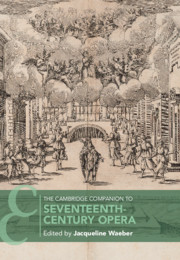Book contents
- The Cambridge Companion to Seventeenth-Century Opera
- Cambridge Companions to Music
- The Cambridge Companion to Seventeenth-Century Opera
- Copyright page
- Contents
- Music Examples
- Figures
- Tables
- Contributors
- Preface
- Chronology
- Abbreviations
- Part I The Italian Foundations
- 1 Opera Is Born
- 2 ‘…e poi le parole’
- 3 Aria, Recitative, and Chorus in Italian Opera
- 4 Opera as Spectacle, Opera as Drama
- Part II Society, Institutions, and Production
- Part III National Traditions (outside Italy)
- Further Reading
- Index
2 - ‘…e poi le parole’
Towards a History of the Libretto
from Part I - The Italian Foundations
Published online by Cambridge University Press: 08 December 2022
- The Cambridge Companion to Seventeenth-Century Opera
- Cambridge Companions to Music
- The Cambridge Companion to Seventeenth-Century Opera
- Copyright page
- Contents
- Music Examples
- Figures
- Tables
- Contributors
- Preface
- Chronology
- Abbreviations
- Part I The Italian Foundations
- 1 Opera Is Born
- 2 ‘…e poi le parole’
- 3 Aria, Recitative, and Chorus in Italian Opera
- 4 Opera as Spectacle, Opera as Drama
- Part II Society, Institutions, and Production
- Part III National Traditions (outside Italy)
- Further Reading
- Index
Summary
Any attempt to write a history of the libretto is fraught with paradox. Almost without exception, a text is the starting point for any opera. Indeed, before Mozart, and often after, the libretto was normally complete before the composer put pen to paper, for all that it might then be revised according to the musical and other demands made upon it. As we shall see, its poetry usually had quite precise musical implications. Moreover, in early opera the poet was normally the prime mover in the operatic enterprise, not just by devising the subject and fleshing it out with appropriate words, but also given his often standard role as director of the production. The libretto was itself the public face of opera in terms of the artefacts that survive to record a given performance: libretti were usually printed for general consumption inside or outside the theatre, whereas musical scores were, on the whole, regarded as more ephemeral performance materials, to be adopted, adapted, and disposed of at will. Poets also acted as the chief ideologues of opera, promoting and defending the genre against its detractors and inserting it into broader literary and cultural debates. In a very real sense, the history of the libretto is the history of opera tout court.1
- Type
- Chapter
- Information
- The Cambridge Companion to Seventeenth-Century Opera , pp. 22 - 38Publisher: Cambridge University PressPrint publication year: 2022



